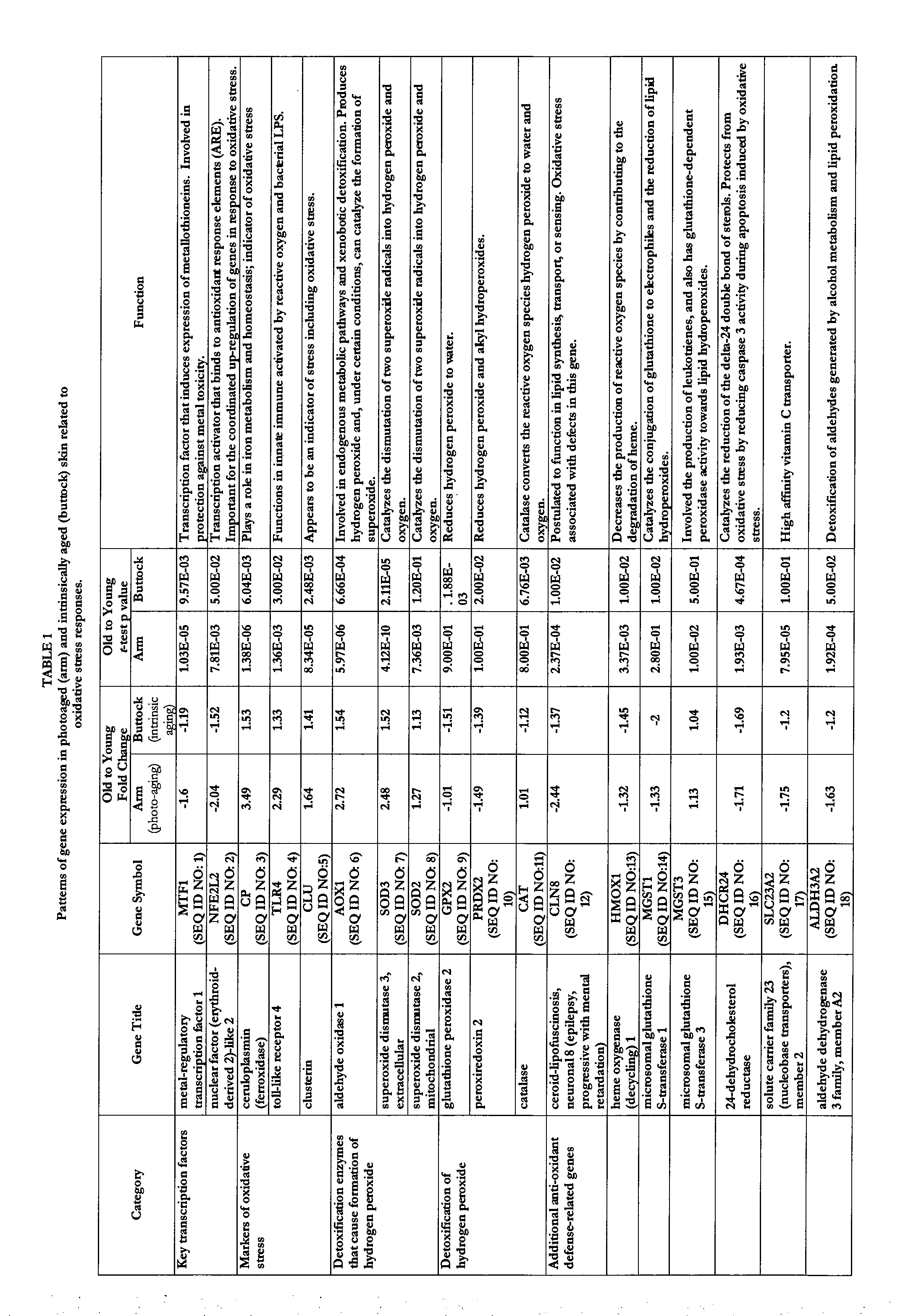Transcriptional Profiling and Biomarker-Based Methods for Identifying and Evaluating Agents for Antioxidant Efficacy in Cosmetic Skin Care Formulations
a transcriptional profiling and biomarker technology, applied in the field of transcriptional profiling technologies, can solve the problems of free radical imbalance, toxic effects, aging and accelerated aging, etc., and achieve the effects of restoring the skin to a desirable redox state, restoring the oxidative balance of the skin, and reversing or preventing oxidative stress in skin cells
- Summary
- Abstract
- Description
- Claims
- Application Information
AI Technical Summary
Benefits of technology
Problems solved by technology
Method used
Image
Examples
example 1
Generation of the Unique Panel of 22 Genes Relating to Oxidative Stress in Intrinsically and Photo-Aged Skin
[0049]A comparison of transcriptional expression in young sun-protected, old sun-protected, young sun-damaged and old sun-damaged skin. Subjects included ten young (ages 18-20) and ten aged (ages 60-67) females. Three 4 mm punch biopsies were obtained from each of two skin sites on each subject: sun protected (buttocks “YB” and “OB”) and sun-exposed (outer forearm, “YA” and “OA”). The older subjects were selected partly on the basis of having visible moderate to severe photo-damage on the forearm. RNA was extracted and purified from the biopsies. Labeled target cRNA was synthesized and analyzed using Affymetrix® HG-U133 Plus 2.0 microarrays containing 54613 probe sets covering the entire human genome.
Identification of genes related to antioxidant defenses or oxidative stress was according to the following protocol: (1) Functional annotations for genes on the HG-U133 Plus 2.0 G...
example 2
Application of Transcriptional Profiling Methods; Generation of Transcriptional Profiles for Skin Explants Treated with Olivem™ 460 and GFF
[0056]Skin explants were collected from surgical waste (abdominoplasty, 46 year old female) and processed the same day. Processing was done by rinsing the skin sample in cold PBS, the subcutaneous fat was removed with a scalpel, the edges were re-cut, and then 1.3 cm squares were collected. Each square was placed on a transwell filter in a 6 well plate and 80 ul of treatment was applied topically. Explants were treated with Olivem™ 460 (Olive Oil DFFAP) (0.1%) plus GFF (20%) in water, incubated at 33° C. at 95% humidity for 3 days then the treatment was removed. The tissue was incubated an additional 3 days and 4 mm punches were taken and quick frozen in liquid N2 for later RNA isolation and PCR analysis with primers specific for the genes. Control skin was untreated.
[0057]A table of the genes transcriptionally regulated by treatment with a cosme...
example 3
Application of ARE Activation Assay and Hemi-Oxygenase1 ELISA to Assess Antioxidant Activity of Proposed Agents
[0058]The antioxidant properties of Olive Oil DFAP, Signaline and GFF are demonstrated by results derived from the ARE transcription assay and an ELISA biomarker assay wherein the biomarker is a phase 2 enzyme, HO-1. Results are also set forth for the heme-oxygenase) (HO-1) biomarker test using human skin explant cultures.
[0059]Primary cultures of human skin keratinocytes and fibroblasts and ex vivo human skin cultures (explants) were treated for 24 hours with specific olive oil derivatives (Olive Oil-Derived Fatty Acids modified with PEG-7 “Olive Oil DFAP”), olive oil blended with jojoba oil (Signaline™) and Galactomyces Ferment Filtrate (GFF). ARE was assayed using the ARE-32 reporter cell line available from CXR-Biosciences and set forth in detail, below:
ARE Assay
[0060]ARE32 is a stable MCF7 cell line containing pGL8x-ARE (8 copies of the rat GST ARE linked to the lucife...
PUM
| Property | Measurement | Unit |
|---|---|---|
| Molar density | aaaaa | aaaaa |
| Molar density | aaaaa | aaaaa |
| Fraction | aaaaa | aaaaa |
Abstract
Description
Claims
Application Information
 Login to View More
Login to View More - R&D
- Intellectual Property
- Life Sciences
- Materials
- Tech Scout
- Unparalleled Data Quality
- Higher Quality Content
- 60% Fewer Hallucinations
Browse by: Latest US Patents, China's latest patents, Technical Efficacy Thesaurus, Application Domain, Technology Topic, Popular Technical Reports.
© 2025 PatSnap. All rights reserved.Legal|Privacy policy|Modern Slavery Act Transparency Statement|Sitemap|About US| Contact US: help@patsnap.com



